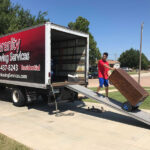
Relocating your restaurant can be a tricky endeavor. Moving large kitchen appliances and fragile tableware requires thorough planning and attention to detail. In this article, we’ll go over several common challenges of moving commercial kitchen equipment before letting you in on some tricks of the trade so you can enjoy a quick and easy move to your new restaurant location.
Challenges of Moving Commercial Kitchen Equipment
Whether you run a small cafe or a Michelin-star restaurant, moving your kitchen equipment might present some challenges:
Heavy and Bulky Appliances
Kitchen appliances are expensive, so it’s important that they are moved safely. However, they are also quite bulky and heavy, and moving them without professional help could result in costly damages.
Fragile and Sharp Items
From delicate tableware to sharp knives, many kitchen items require careful packing to prevent damage and injuries during the move. To avoid increasing the costs of your move, it’s important to have your equipment moved professionally.
Sanitation and Safety
It’s important to keep your kitchen equipment clean during a move to reduce the risk of serving contaminated food. Professional kitchen equipment movers can help you relocate your appliances, utensils, and ingredients safely.
Time Constraints and Business Downtime
Your business will remain out of operation as long as you are busy with your move. Trying to move everything yourself can take a long time and cut into your profit margins.
11 Tips for Moving Commercial Kitchen Equipment
Here are a few tips to make your restaurant relocation easier:
Sort and Organize Your Equipment
The best way to prepare kitchen equipment for packing is to sort it into groups. Here are a few steps to sort and organize your kitchen equipment:
- Get rid of everything that has expired or that you don’t want to keep
- Donate perishable items that haven’t expired yet
- Organize the remaining items by group (appliances, non-perishables, cutlery, etc.)
Create a List of Kitchen Inventory and Take Photos
Before packing your kitchen equipment, create a list of all your items and take photos of valuable ones to document their pre-move condition. The list will keep you from forgetting anything, and the photos will help you check if any items have been damaged during the move.
Clean and Sanitize All Equipment
Before moving, clean and sanitize your kitchen equipment, especially if it comes into direct contact with food or drinks. This will prevent harmful bacteria from developing and allow you to pack and unpack without worrying about dirty equipment.
Gather the Right Packing Supplies
Sometimes, we forget the simplest details, even if they seem obvious. You will need:
- Boxes specially designed for kitchenware
- Bubble wrap
- Packing tape
- Labels and markers
Disconnect Large Appliances
Disconnect large kitchen appliances, such as refrigerators, freezers, and dishwashers, at least a day before the move. Make sure you keep fridges and freezers upright during the entire move to reduce the risk of damage.
Wrap Fragile Items Individually
Fragile items require individual padding to keep them from knocking against each other and cracking. You can use bubble wrap and packing paper to wrap fragile items individually before placing them inside a box with dividers. You can also use bubble wrap to protect fragile items.
Pack Heavier Items at the Bottom
When packing and stacking items in boxes, make sure you place heavier items at the bottom. The same goes for stacking boxes once they have been packed. This technique makes sure that smaller items don’t get crushed at the bottom of a box.
Label Boxes Clearly
Labeling is very important when moving kitchen equipment. You can label boxes by group, and you can also label items that are particularly fragile or heavy. Using color-coded labels can make the process even easier.
Pack Sharp Objects Carefully
Pay special attention when packing sharp kitchen supplies, such as knives and forks. We recommend you use a case specially designed to transport knives and other sharp items. Many knife sets come with a travel case when they are purchased.
Plan for Business Downtime and Co-ordinate Your Move-In Time
The longer your move takes, the longer your business will remain closed. That’s why it’s important to plan ahead. Develop a detailed packing, cleaning, moving, and unpacking plan to make your move seamless.
Hire Professional Movers
It’s always better for restaurant owners to hire professional movers. Professional moving companies have experience packing, loading, transporting, unloading, and unpacking commercial kitchen equipment. They will make sure your appliances make it to your new location without a scratch.
Serenity Moving Services Can Help
At Serenity Moving Services, we have extensive experience planning and executing commercial kitchen moves. From packing and unpacking to loading and unloading, we’ll take care of each step of the move so that your restaurant can relocate as quickly as possible. We use industry-standard tools and equipment to transport your items safely.
Our services are cost-effective and take the stress out of relocating your restaurant. Call or email us and get a free quote today!
Frequently Asked Questions (FAQs)
Yes. If any of your items are damaged during the move, you will be compensated. However, after 12 years in the business, less than one percent of our moves have resulted in damages.
Yes, movers are experienced in packing and unpacking small kitchen tools and bulky kitchen equipment. They only use quality packing supplies to ensure each item is safe.
The time it takes to move commercial kitchen equipment depends on the amount and size of the equipment and the distance that needs to be traveled. Serenity Moving Services can give you a time estimate based on the details you provide.
The cost of moving commercial kitchen equipment depends on several factors, including the amount and size of the equipment, the distance to be traveled, and the number of services you require packing, unpacking, post-unpacking clean-up, etc.





